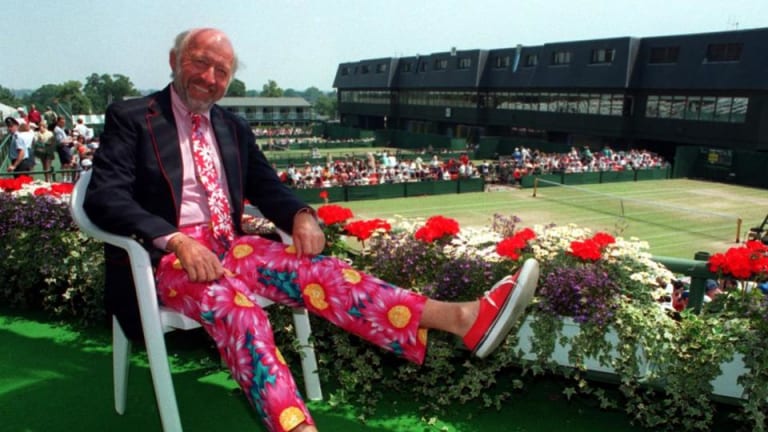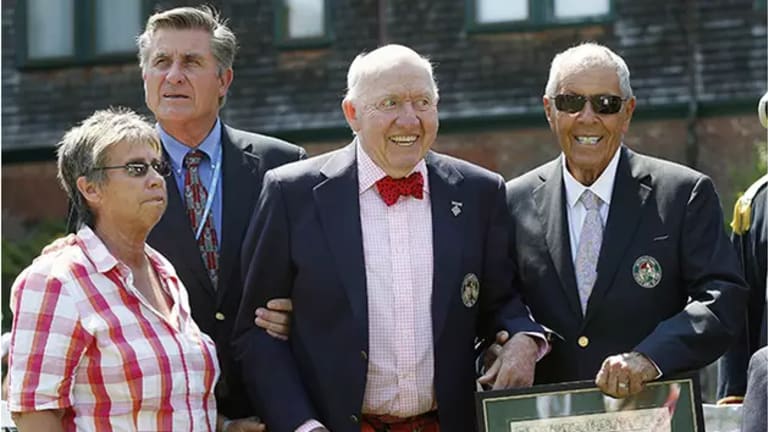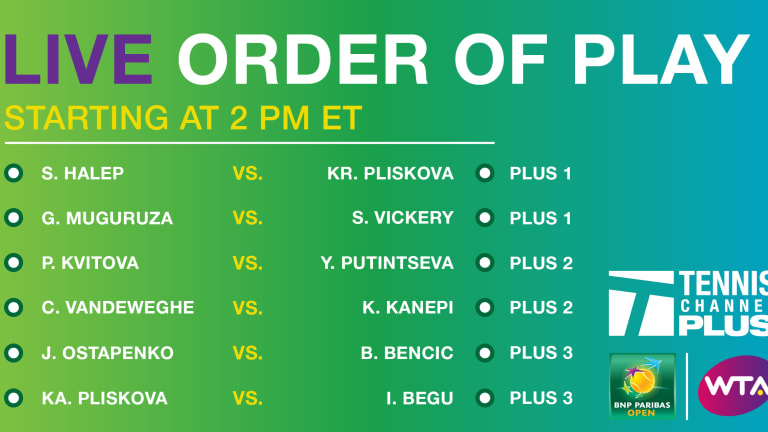Editor's Note: It's Bud Collins Day at the BNP Paribas Open. As the legendary writer and broadcaster is being honored at Indian Wells, read about the man and colleague from one of his closest friends, fellow Hall of Fame journalist Steve Flink.
Bud Collins, to be honored at Indian Wells, is an irreplaceable icon
By Steve Flink Mar 08, 2018Stat of the Day
Danielle Collins extends winning streak to 14 matches in a row with opening victory in Madrid
By John Berkok Apr 26, 2024Social
'If we're both fit enough, why not?' Carlos Alcaraz and Rafael Nadal reaffirm Paris Olympic doubles hopes in Madrid
By Baseline Staff Apr 26, 2024Social
Mirra Andreeva did, in fact, put Andy Murray's famous complimentary tweet in a frame
By Baseline Staff Apr 26, 2024Madrid, Spain
Ready (in) '24: Tommy Paul turns injury break into clay-court training bloc, aims to peak at Roland Garros
By David Kane Apr 26, 2024Madrid, Spain
Carlos Alcaraz begins Mutua Madrid Open title defense, defeats Alexander Shevchenko
By David Kane Apr 26, 2024Defending champion Sabalenka advances at Madrid Open with a 3-set win over Linette
By Associated Press Apr 26, 2024Pop Culture
New movie Challengers asks: Where does tennis take us?
By Joel Drucker Apr 26, 2024Madrid, Spain
Aryna Sabalenka defeats Magda Linette, begins Mutua Madrid Open title defense
By David Kane Apr 26, 2024Social
Shelby Rogers dishes on the viral social media video that went all the way to Will Smith
By Baseline Staff Apr 26, 2024Bud Collins, to be honored at Indian Wells, is an irreplaceable icon
Published Mar 08, 2018
Advertising
When we assess the people who have contributed to the popularity of tennis, the central figures are predominantly players. Luminous champions from Bill Tilden to Roger Federer and Suzanne Lenglen to Serena Williams stand out most prominently. Without the great players and their enduring exploits, tennis might have been lost in the shuffle of history, relegated to a lesser role in the world of sports and entertainment.
Examining tennis and its modern evolution in the United States as a spectator sport, few individuals have done more in lifting the game to a lofty public platform than Bud Collins. Just over two years ago, on March 4, 2016, Collins passed away at 86 after a period of deteriorating health. For more than half a century in his country, Collins was the sport’s most far-reaching contributor outside of the competitors themselves. And in certain respects, his impact was larger.
Making that claim about Collins is not hyperbolic. Having grown up in Ohio, Collins attended Boston University Graduate School. He coached the Brandeis University tennis team in Massachusetts from 1959 to 1963 and was a remarkable player, winning the U.S. Indoor Mixed Doubles title alongside Janet Hopps in 1961.
Collins, however, was destined to be not a player or a coach, but a communicator. He went to work for the Boston Herald in the late 1950s as a sports writer. By 1963, he had landed at the more prestigious Boston Globe. He would remain at that newspaper until the latter years of his life, writing on a variety of sports but excelling with his coverage of tennis. The same year he started with the Boston Globe, Collins made his debut as a tennis commentator, calling the U.S. National Doubles Championships in Brookline, Massachusetts for WGBH, a crucial line in the PBS family.
The relationship between Collins and PBS would flourish. Some of his finest work for that network was done in the 1970s. Joined by Donald Dell, Collins would infuse his telecasts with reverence for the traditions he loved and irreverence for anything he regarded as pompous or stodgy. He could be zany and irrepressible, yet unfailingly dignified at the appropriate moments.
Meanwhile, Collins was the stalwart play-by-play commentator for CBS at the first five US Opens from 1968 up through 1972, the year he commenced a 35-year stint with NBC as an announcer. Collins established himself indisputably as the face of tennis in the United States. His familiarity with the fans exceeded that of many well-known players. Collins connected lastingly with the public because he was a serious student of the game who never took himself too seriously, a masterfully entertaining fellow, and a man who built a reputation as a walking encyclopedia of tennis.
Advertising

Bud Collins, to be honored at Indian Wells, is an irreplaceable icon
My introduction to Collins came in 1969 on the hallowed grounds of Wimbledon. I was 17, and my overriding goal in life was to become a tennis reporter. My father had crossed paths with Bud many years earlier, and he felt I should meet Bud and inform him about my aspirations. After walking up a flight of stairs, a guard directed us to a door, which led to a small pressroom.
We knocked on that door, and moments later an affable Collins emerged, wearing that reassuring and infectious smile that I would get to know so well over the decades. My father told Bud about the career path I had in mind, and Collins warmly responded with something along the lines of, “You picked the right game to write about. Stick with it. Good luck, and stay in touch.”
I did just that, and saw him periodically during the next couple of years. And then, in 1972, I worked for Collins as a statistician and assistant at Wimbledon and the US Open, helping him with his newspaper columns and commentary. I learned immeasurably from observing Bud as he practiced his craft. I was well aware that Bud had a reservoir of knowledge about the game, but fortunately I found that my photographic memory could supplement the considerable stock of facts he had stored in his nimble brain.
From that juncture on, I worked frequently with Collins behind the scenes on his telecasts. Later, in the eighties, we did some on-air commentary together. When I landed a full-time position at World Tennis Magazine in 1974, it was a job I had secured to a large extent because of the reputation I had garnered from being around Bud. I was ever mindful of the role he had played in helping me launch my career.
Meanwhile, I continued to marvel at the agility of Bud's mind, the fundamental decency of the man, and the way he went about his professional pursuits. I believe that the shining moment for Bud Collins as a broadcaster was his masterful call of the epic five-set Bjorn Borg-John McEnroe Wimbledon final of 1980, which the implacable Swede took 8-6 in the fifth set. I had the good fortune to be sitting next to him in the booth, as a statistician for NBC, and what he did that day was stupendous.
In those days, the networks used statistical graphics sparingly. It was, therefore, incumbent upon the announcers to supply all of the pertinent information to the viewers, as swiftly and lucidly as possible. In the fourth-set tiebreaker of that classic, McEnroe, who had already saved two match points when Borg served for the match earlier in the set, gallantly fought off five more. Ultimately, McEnroe prevailed in that singularly gripping sequence 18-16. It remains the greatest tiebreaker that I have ever seen in a major final.
Even for the most erudite and effusive fans, that tiebreaker was factually very difficult to follow. But the unshakable, clear-minded, sharp-witted Collins did not skip a beat. He kept the fans in their homes impeccably informed. His clarity of thought and deep enthusiasm turned a treasure of a match into something that transcended tennis. He made it all soar. That was no mean feat. Only Collins could have done that.
Advertising
Come to think of it, he managed to raise his game just about every year, not only with his boundlessly effusive manner in the booth, but even more tellingly during his post-match interviews with the champions and runner-ups at Wimbledon. From the mid-seventies until 2000—when the BBC first elected to speak to the players as part of the presentation ceremony—Collins would leave the booth and be the first to greet the competitors as they took their first steps off the court on their way to the locker room.
Collins would stand there in his trademark garish trousers, and then display a brand of dignity that could only belong to him. The losing finalist would invariably be melancholy, but Collins would follow his instincts and cheer the player up with a blend of praise, humor and kindness that only he could have summoned. He had the gravitas to step in and empathize with the loser, graciously congratulate the winner, and handle the whole matter genially.
Through the years, he spoke with the likes of Borg and Connors, Evert and Navratilova, Agassi and Sampras, Graf and Federer. Win or lose, they found comfort coming off the fabled Centre Court and seeing the familiar face of Bud Collins. The players knew they could count on Collins to understand precisely what they were feeling and conduct himself with commendable restraint and sensitivity.
And yet, as much pride as he took in his contributions to broadcasting, his work in print mattered just as much to Collins. He wrote autobiographies with both Laver and Evonne Goolagong, and did a memoir of his career called My Life with the Pros in 1990. His first tennis encyclopedia was released in 1979, and through the rest of his life he put out countless updated editions of Bud Collins History of Tennis. That crucial tome remains out in the forefront of the tennis public to this day, thanks to his indefatigable widow, Anita Klaussen. They were married in 1994, and she was a ceaselessly ardent supporter and unwavering companion until the end of his life. His work lives on through Klaussen’s devotion and unflagging spirit.
But the encyclopedia was not the only signature item in the Bud Collins line of writing. His Boston Globe columns were priceless pieces of his wit and wisdom. Meanwhile, he wrote longer articles for magazines, most importantly World Tennis from the 1970s into the nineties. Perhaps the gutsiest piece he ever submitted for that publication was a 1976 cover story entitled, “Are the Pros Conning Us?”
Bud’s photo was on that cover, deservedly so. The piece was fair-minded but tough, sharply critical of some leading players yet not too cynical and never out of bounds. He felt that he was witnessing too many less than maximum efforts from top competitors outside of the Grand Slam tournaments, and his cases were well documented.
As a journalist with unimpeachable credibility who was very fond of the players, this was a defining moment for Bud as a reporter. He was tender and tough, unswervingly critical of the players but not heavy handed. That was the essence of Bud’s entire career. He was a professional’s professional, secure and authentic, ever true to his core values.
Advertising

Bud Collins, to be honored at Indian Wells, is an irreplaceable icon
Six months before he passed away, Collins received a singularly important honor from the USTA. They fittingly renamed the US Open pressroom the Bud Collins Media Center. This was right in the middle of the tournament. A wide range of reporters and players showed up to honor this revered figure. In his wheelchair, Bud sat in front of an honorary plaque that hung above him—including a wonderful photo that depicted him beautifully— surrounded by friends and colleagues from near and far.
Among the renowned writers who showed up were Mike Lupica, George Vescey and John Feinstein. The champions who attended this celebratory occasion included Billie Jean King and Tracy Austin. Speeches were delivered eloquently by the likes of King, Tennis Channel CEO **Ken Solomon and USTA President Katrina Adams. Their remarks varied in tone and texture, but it was all poignant. Bud spoke softly, almost in a whisper, but, even in that weakened state, his wit was undiminished. He asked Adams—who was once ranked in the world’s Top 10 as a doubles player—if she was a left-hander. Adams said that she was not. “Well, “he said without hesitation, “you should have been!”
It was apparent to me that Collins was immensely grateful to be there. Somehow, Anita had managed to get Bud out to the facility. Only she could have pulled that off. He looked over at me at one stage, smiled, and said, “Stefano, good to see you.” That was a chilling moment. I did not expect to ever see him again.
Anita planned her memorial for Bud at the Trinity Church in Boston on his birthday, June 17, 2016. I was humbled to be one of the ushers that day, along with Rod Laver, Stan Smith, Donald Dell, Dick Enberg and a host of others. King and Chrissie Evert were among those who gave powerful eulogies. The church overflowed with tennis and sports figures like Mary Carillo, Lupica, Curry Kirkpatrick and Frank DeFord, and even Michael Dukakis, the former Governor of Massachusetts, was there. The turnout demonstrated that Bud Collins was much larger than a standout journalist in the world of sports; his influence was far-reaching and transcendent.
It was a lovely farewell to a fellow we all cherished in a multitude of ways. For me, it was a splendid occasion, uplifting in many ways, befitting of the man. Yet Bud was gone forever. As I left the church and moved on to the reception, I tried to put the sadness behind me and dwelled on the laughter we shared so frequently in the nearly 48 years I knew him. Once, in the 1980s, a mutual friend, Wayne Kalyn, had moved on from an editing job at World Tennis Magazine to join another publication.
“He’s going to a general interest magazine,” I told Bud. “What do you think about that?”
“Well, Steve, I don’t know what a general interest magazine is, and I don’t think you do either. But maybe he can bring you and me along and we can get in on some of these general interests. It might be great for all of us.”
That was the essential Bud Collins: ever attentive to others, uncommonly generous, uniquely amusing and, above all, original. We miss him immensely.
Advertising

Bud Collins, to be honored at Indian Wells, is an irreplaceable icon
From Day 1 through to the Finals.
Up to 7 courts, including the biggest matches of each day.
Live and on-demand.